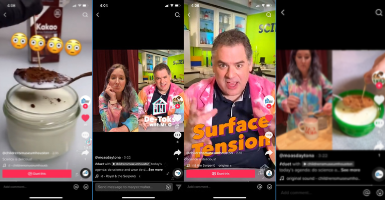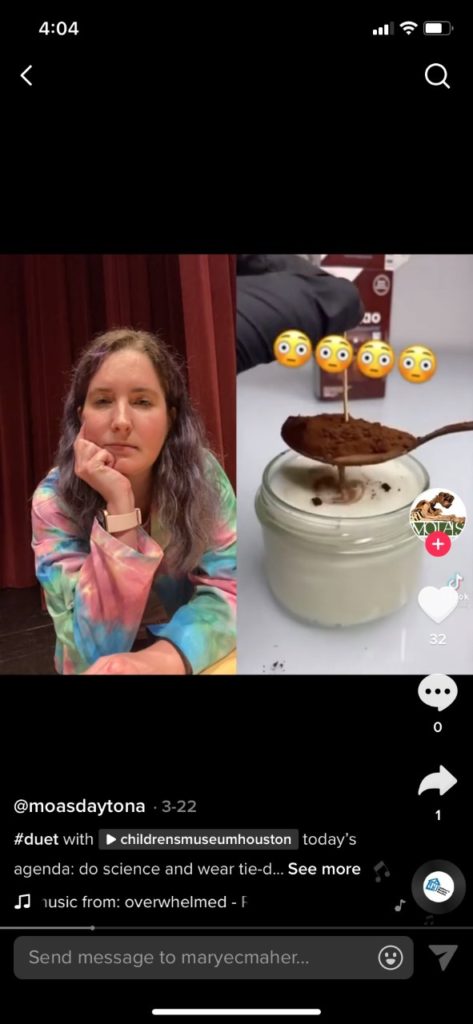June 13, 2022 / News & Blog

| This article is part of the “Communications 2022” issue of Hand to Hand. Click here to read other articles in the issue. |
By Keith Ostfeld and Henry Yau, Children’s Museum Houston
For years, Children’s Museum Houston has been using social media to reach our audience for announcements, special deals, silly puzzles, and especially fun videos and livestreams. Like most children’s museums that use social media, our focus has been on engaging parents and caregivers, who are the primary users of social media, with content they can also share with their kids (at least until the kids get savvy enough to demand the videos themselves). Facebook, YouTube, and, more recently, Instagram have served us very well in reaching our audience. But then things changed…
We first became aware of TikTok back when it was still called Musical.ly, which began in 2014 and changed to TikTok in 2018. Back then, the demographics of users skewed heavily into the teens—not our core audience. But we kept an eye on it, figuring that, much like younger parents were choosing Instagram over Facebook, as TikTok’s users aged, it may become a popular social media choice for young parents.
And then…well, you know. During the first quarter of 2020, while we were all trapped in our homes and hungry for entertainment, TikTok had the biggest quarter of any app ever with over 315 million downloads. It currently boasts more than 138 million monthly active users in the U.S., of which 29.5 percent are 20-29 and another 16.4 percent are 30-39—the userbase aged up quickly!
A little sooner than expected, it was time to get onto TikTok. And while it was uncharted territory, the Children’s Museum Houston, driven by our passion for discovery and lifelong learning (and fueled by coffee), loves to delve into new experiences. We quickly discovered that TikTok has some unique quirks that make it very different from other platforms. Our challenge lay in how to produce the videos to optimize the platform.
First and foremost, TikTok is a mobile-first platform. Many social media platforms started with content shared through computers, so horizonal video formats worked well on computer monitors. Over the years, as how we consume content has shifted towards mobile devices, vertically formatted videos—like the videos on TikTok—have become more popular. The popularity of this format on TikTok has led other platforms, including Instagram, Snapchat, YouTube, Google, and even Netflix, to add mobile-first options.
In addition, while many of our videos that we shared on Facebook and YouTube could be lengthy, TikTok videos had to be short, snappy, and visually engaging. Most TikTok users decide whether to continue watching a video in the first three seconds, plus there is typically a time limit to the videos. In addition, TikTok users also tend to skip videos that look too professional; a homemade feel is more popular.
With this in mind, we restructured our shooting formats. First, we made sure that we shot clips vertically, often opting to use a mobile phone for the shoot. Second, we started planning and scripting our videos differently, aiming for a quick visual grab and shorter timeframe. Finally, we started using a different style during production, opting for less structure and encouraging more free-form movement of the camera. The result were videos which both aligned with our programming and how TikTok audiences consume content.
We first ventured into creating content for TikTok to tap into a new audience base in the summer of 2021, during our post-pandemic reopening. We had hired two amazing young interns who were already regular consumers of TikTok and familiar with its trends. Since we were launching, we gave our interns the liberty to explore different types of formats to see what would work best to create views while remaining in line with our brand.
Some of their first explorations involved “tiny mic interviews,” where they would interview our staff and visitors with simple questions about current trends like superhero movies. While these interviews were fun to produce, we didn’t get very consistent viewership.
Next, they tried “museum exploration” videos, where they explored different exhibitions, sometimes focusing on a few exhibits, as a way of “touring” visitors through the museum experience. These videos created consistent viewership, but not huge numbers of viewers.
However, the third type of videos they created, which included TikTok viral trends, was more successful. (You can see what’s trending on TikTok under their sounds option. “TikTok Viral” includes a current list of widely used tracks.) They would look for trending styles and challenges that were in alignment with the museum’s brand and riff off those. These by far produced the most views, into the thousands.

DeToks – We search out videos on TikTok showing science experiments, based on scant or incorrect facts, being done at home. We either prove and explain them (e.g., dipping a spoonful of cocoa powder into a bowl of milk will cause a film to form around the cocoa which can be “popped” using a toothpick) or debunk them with an explanation (e.g., proving that toothpaste will NOT dissolve an eggshell).
By the end of that summer, we established that there was both an audience for and interest in what we do on TikTok. With this information in hand, we went back to the education team to begin developing a plan in sync with our other video work to create TikTok-specific content. This effort resulted in two main standouts:
With this success, we have started exploring other ways to adapt our existing video work for TikTok, including creating shorter and/or sped-up versions of previously recorded videos and new styles of video content that take advantage of current TikTok trends.
But we aren’t doing any #stupidchallenges.
Keith Ostfeld is director of educational technology and exhibit development and Henry Yau is director of communications at Children’s Museum Houston.